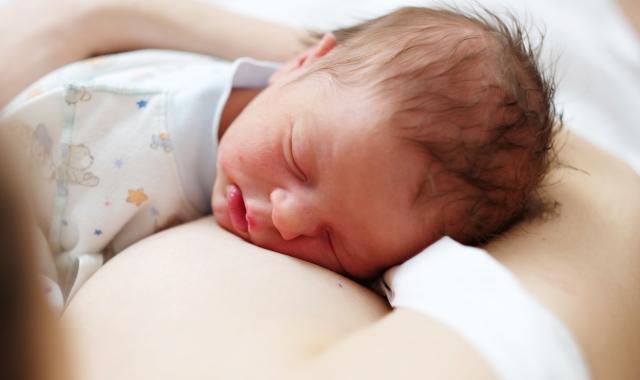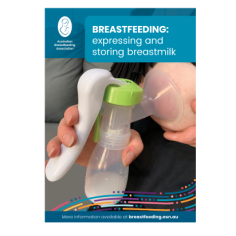If you aren't able to feed your baby from your breast you can express your ‘liquid gold’!

Congratulations on the birth of your baby! If your baby can’t feed from your breast yet or is having trouble attaching, you may need to express.
Colostrum is the first milk you will make and it’s very important, especially if your baby is premature or sick. Start expressing as soon as you can after the birth and express every few hours. At first you’ll only get a few drops of this precious ‘liquid gold’, but it's just what your baby needs.

How much colostrum does my baby need?
Your newborn baby’s stomach only holds a small amount (about a spoonful) of milk. Premature babies need even less.
This is why newborn babies feed so often in the first few days, and why you need to express often if your baby is unable to feed at the breast, or too sleepy to feed often.
Healthy, term breastfed babies tend to drink these amounts at each feed during the first week:1
1 day old - 2 to 10 mL
1 to 2 days old - 5 to 15 mL
2 to 3 days old - 15 to 30 mL
3 to 4 days old - 30 to 60 mL
How do I express colostrum?
You will only be able to express a very small amount, maybe only half a teaspoon, if you express in the first few days after birth. This is normal and enough.
Colostrum is thick and small in volume, so hand expressing may work better than a pump in the first day or so.2,3 To begin with, you may like to collect the drops of colostrum with a small syringe or teaspoon. A midwife or your partner may help you express your breasts by hand if you are unwell.
Around 2 to 6 days after birth your milk supply will increase and you’ll notice the colour start to change from yellow to white. You’ll also notice that you can express more. At this time most mums become aware of their let-down reflex.
As your supply increases, you may find it helpful to begin using a breast pump, or combining pumping with hand expressing.
How often and how much should I express?
This will depend on why you are expressing.
- Your baby may be in special care or NICU. They may be having some but not all feeds at the breast.
- You may have left hospital and be bringing your expressed breastmilk to them.
- You may be at home with your baby but still establishing feeds at the breast.
Your baby may only be taking very small amounts of milk at first. You will still need to build up the amount you express to 500 to 700 mL per day by the end of the second week. This may sound like a lot to start with, but nearly all mums can produce this much (and more) if they express frequently. If you express often, the amounts you express will soon increase.
Try to express as often as you can. Newborns need to breastfeed about 8 to 12 times in 24 hours, so that’s how often you'll need to express to have the same amount of milk ready for your baby.
The time taken to express will vary but will usually be no more than 20 minutes for each breast, or in total if double pumping, from the time of the first let-down (eg when your milk starts flowing). If your milk is still flowing (not just dripping) at 20 minutes, it is fine to continue until that flow has stopped.
Many mums express different amounts from each breast. It’s normal to have one breast that makes more milk than the other. It’s also normal to produce different amounts of milk each time you express.
When you take the available colostrum, and then milk, from your breasts often, your breasts will learn to make more for your baby. This is known as 'supply and demand'.
Ideas to help build your supply
- If your baby is able to suck at your breast, it will be important that you get help with attaching as soon as possible. Your baby will be able to remove your colostrum and breastmilk more easily than you can express it.
- Express close to your baby if you can so that you can touch, see, smell and hear them. This can help the milk to flow.
- Spend as much time as possible holding your baby skin-to-skin.4
- Most hospitals will recommend that you express every 2 to 3 hours during the day and at least every 4 hours at night. This is tiring, but night sessions are important as they help build a healthy milk supply.
- Leaving long gaps between sessions won’t help your milk supply. You'll make more milk if you express until your breasts feel empty and do this more often. Stretching out the time between expressing means that, over time, you will produce less milk.
- Expressing to a regular timetable will help you remember to express your breastmilk as often as is needed and build a good milk supply.
- You may find you can express more in the early hours of the morning than at other times.
- Research shows that most mums can express more milk by using a hospital-grade electric breast pump.
- ‘Double pumping’ (expressing both breasts at once) is faster and more effective than expressing one breast at a time.5
- Using a hospital-grade electric pump together with 'hands-on pumping' can help to get as much milk from your breasts as possible. To do this, massage the breasts while using the pump and then hand express after the flow stops. Most mums can greatly increase their milk this way compared to using a breast pump alone.6
Aim to express at least 8 times a day, including 1 or 2 sessions during the night, to build and maintain your milk supply.
Feeding your expressed breastmilk to your baby
If you need to feed expressed colostrum or milk to your newborn baby, a spoon or syringe is all you need because they only need a small amount. You can also use a small cup.
The importance of support
Having a newborn is a busy time, especially if you have other children to care for. It can be even more stressful if your baby is sick, premature or unable to breastfeed for other reasons.
Expressing is a learned skill and will improve with practice. Seek help if you are struggling to express enough for your baby. Celebrate milestones and success with your own milk volumes rather than comparing yourself to other mothers. Any breastmilk you can express is the best food and medicine for your new baby.
Further information
Below are some links to external sites containing video clips showing expressing (including hand expressing) and storing breastmilk. Please note that the opinions expressed at the sites listed below do not necessarily reflect those of the Australian Breastfeeding Association.
-
Hand Expression of Breastmilk (Premature Babies) - Stanford School of Medicine - Dr Jane Morton MD- 7:33m
-
Maximizing Milk Production with Hands On Pumping (Premature Babies) - Stanford School of Medicine - Dr Jane Morton MD- 9:35m
© Australian Breastfeeding Association April 2023
- Kellams, A., Harrel, C., Omage, S., Gregory, C., & Rosen-Carole, C. (2017). ABM Clinical Protocol #3: Supplementary feedings in the healthy term breastfed neonate, revised 2017. Breastfeeding Medicine, 12, 188–198.
- Ohyama, M., Watabe, H., & Hayasaka, Y. (2010). Manual expression and electric breast pumping in the first 48 hours after delivery. Pediatrics International, 52(1), 39–43.
- Morton, J., Hall, J. Y., Wong, R. J., Thairu, L., Benitz, W. E., & Rhine, W. D. (2009). Combining hand techniques with electric pumping increases milk production in mothers of preterm infants. Journal of Perinatology, 29(11), 757–764.
- Hurst, N. M., Valentine, C. J., Renfro, L., Burns, P., & Perlic, L. (1997). Skin-to-skin holding in the neonatal intensive care unit influences maternal milk volume. Journal of Perinatology, 17(3), 213–217
- Prime, D. K., Garbin, C. P., Hartmann, P. E., & Kent, J. C. (2012). Simultaneous breast expression in breastfeeding women is more efficacious than sequential breast expression. Breastfeeding Medicine, 7(6), 442–447
- Morton, J., Hall, J. Y., Wong, R. J., Thairu, I., Benitz, W. E., & Rhine, W. D. (2009). Combining hand techniques with electric pumping increases milk production in mothers of preterm infants. Journal of Perinatology, 29, 757–764.
Read more about expressing and storing
Evidence-led info and practical tips from our Breastfeeding Information Series
Breastfeeding: expressing and storing breastmilk




